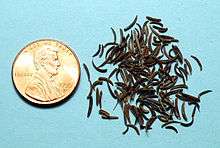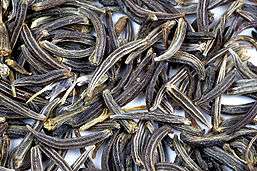Bunium bulbocastanum
| Bunium bulbocastanum | |
|---|---|
 | |
| Scientific classification | |
| Kingdom: | Plantae |
| (unranked): | Angiosperms |
| (unranked): | Eudicots |
| (unranked): | Asterids |
| Order: | Apiales |
| Family: | Apiaceae |
| Genus: | Bunium |
| Species: | B. bulbocastanum |
| Binomial name | |
| Bunium bulbocastanum L. | |
| Synonyms[1] | |
| |
Bunium bulbocastanum is a plant species in the family Apiaceae. It is related to cumin (Cuminum cyminum) and commonly called black cumin, blackseed,, black caraway, or great pignut,[2] and has a smoky, earthy taste. It is often confused with Nigella sativa (which is also called black cumin,[3] blackseed, and black caraway[3]).
Dried Bunium bulbocastanum fruits are used as a culinary spice in northern India, Pakistan, Bangladesh, Afghanistan, Tajikistan and Iran. It is practically unknown outside these areas. The tuber-like root is locally collected for food; the "pignut" or chestnut" names refer to it.
Etymology
Local names for that spice are (काला ज़ीरा) kala zeera (black cumin) or shahi zeera (शाहि ज़ीरा)(imperial cumin) in Hindi, as سیاہ زیرہ ("syah zirah", "black cumin"), کالا زیرہ ("kaala zirah", "black cumin") and زيره كوهی ("zirah kuhi", "mountain/wild cumin") in Urdu, زيره كوهی (zireh kuhi, "wild cumin") in Persian and as сиёх дона (siyoh dona, "black seed") in Tajiki, in Malayalam "സഹജീരകം".
The commonly used Hindi term shahi zeera may be a distortion of syahi (black in Persian) zeera. However, in the Hindustani language, the term syahi also means "inky black". In Bengali, kalo zeera also means black cumin, but refers to Nigella, not B. bulbocastanum. Nigella is widely used as a spice in Bengali food, while B. bulbocastanum is rare.
Growth
The plant grows wild in a wide range from southeastern Europe east to southern Asia. It reaches about 60 centimetres (24 in) tall and 25 centimetres (9.8 in) wide, bearing frilly leaves and hermaphroditic flowers; it is pollinated by insects and self-fertile.

Uses
The plant bears small-sized seeds and one can pluck them once the plant is very dry. Not more than 5 to 8 grams of zeera can be plucked from each plant, contributing to the high price of $2 per 10 g (1987 rates).
The small, rounded taproot is edible raw or cooked, and said to taste like sweet chestnuts. The leaf can be used as an herb or garnish similar to parsley.
The seeds are most valued as a garnish to high value, very special Indian dishes; they should not be ground as their flavor would be reduced.
References
- ↑ "The Plant List: A Working List of All Plant Species".
- ↑ "BSBI List 2007". Botanical Society of Britain and Ireland. Archived from the original (xls) on 2015-01-25. Retrieved 2014-10-17.
- 1 2 "Bunium persicum information from NPGS/GRIN". www.ars-grin.gov. Retrieved 2008-03-13.
External links
-
 Data related to Bunium bulbocastanum at Wikispecies
Data related to Bunium bulbocastanum at Wikispecies -
 Media related to Bunium bulbocastanum at Wikimedia Commons
Media related to Bunium bulbocastanum at Wikimedia Commons